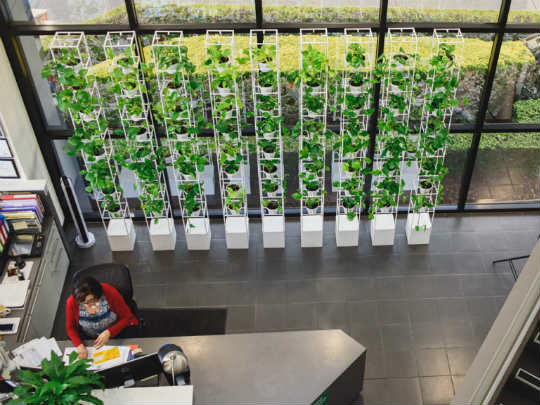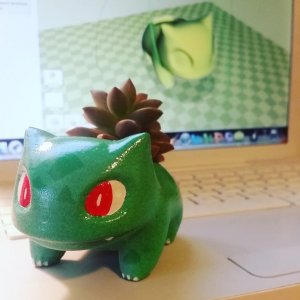Hello everyone! After finishing our first project within the Make All Things series, I was taking a break and looking for some new projects to make. Within the environment of my makerspace, Pumping Station One, the tools to make anything are endless. I have been working on building up the Pumping Station community and I just recently became a board member and the head of Public Relations. I think this space will benefit from the ability of us to showcase different projects we can do as a community. It will also be awesome to involve the Chicagoland area with different things we create.
With that being said, a new project idea was presented to me by a member of the PS1 community. A member wants to lead a project for a vertical garden. It is important to know a couple of things. Firstly, this member has no ideas whatsoever about vertical gardens. Neither do I. Neither do a good amount of the PS1 community. That is the fun part though. Again, being in a makerspace inspires people to try and fail within areas that are outside of their comfort zone. These are the experiences that push us to learn that we have more ability than we can imagine. The goal of this project is to build a vertical garden for someone who lives in a city like Chicago. Living in a larger city typically keeps people away from nature. Topics like botany are very foreign to a majority of city dwellers like myself. It will definitely give myself and anyone else a new mindset and consideration for plant life. We also want to build a system that will grow edible crops that people would use for their own nutrition. This will be a large scale project that will utilize CNC machines, arduinos, rapid prototyping, as well as 3D printing.
We will have different phases of this project. We have been working on our first phase of the project which is dedicated to design research and user research. We are taking a design approach to this project so that this could be a viable option for a large amount of people in terms of implementation. Most of us have no inherent biases about building a vertical garden because we have no understanding of botany, farming or gardens. We are looking to build crops and a garden that would be beneficial to the common person. Having no skills within this field allows us to quickly ask a bunch of questions. This will come before the actual building of the project, and that is key. It forces us to have deliberate consideration of the user. In the previous project I created, the product I built was a ring design that I personally liked. Instead of keeping an insular approach to product design, it is important to gain outside perspective.
An Example of a Vertical Garden
Some of the questions already built by the group of organizers we have for this project are the following:
- How loud would this be in someone’s house?
- How much energy does it require?
- What’s the upkeep for the plants ? (can it be automated)
- What plants do we actually need to grow?
- How seamless can the process be?
- How much light do we need?
- How much water do we need ?
- How large is the system?
- How do the plants intake the nutrients?
- How do plants get from a seed to a plant?
- How does the location of the plant affect its growth?
- What are the things people need to know in order to manage the vertical farm?
- How much produce per person do you need to sustain yourself?
- How do we prevent infection in a small space?
- How safe can it be if it’s at home?
- How often can you update your plants and what is the cycle of growth?
- How many can you grow at once?
- What can move people from buying produce to growing their own ?
- How easy is it to set the system?
- How can we control the system?
- What are the parameters that we need to control?
- Can you transfer it to an outdoor environment? ( How can you transfer it?)
- How cheaply can this be made?
- What is the life cycle that we want to set for this?
- What are the materials for that lifecycle?
- How does the system interact with the materials?
- What is our form of energy?
Our core audience will be vegetarians, vegans, and healthy lifestyle individuals as they are the most likely to implement this kind of product readily. Our secondary audience of users include farmers, restaurant chefs, and people with dietary restrictions. A lot of our research will be focused on gaining insight from industry experts. These experts would include home food – growers, agricultural engineers, farmers, restaurant chefs/restaurant owners/catering companies, organic chemistry scientists, bio engineers, and individuals from the nonprofit Plant in Chicago. Once we have done proper research over a month period, we will then be able to build out a prototype product that will utilize various machines including some 3D printing. It will be a fun experience, so watch out for some updates on this project on a weekly basis.
Subscribe to Our Email Newsletter
Stay up-to-date on all the latest news from the 3D printing industry and receive information and offers from third party vendors.
You May Also Like
NSF Awards Kentucky $1M for Advanced Manufacturing
The National Science Foundation has awarded a $1 million grant to the University of Louisville for the Advancing Manufacturing and Building Construction Technologies (NSF AMT) project. This initiative is part...
3D Printing News Briefs, May 11, 2024: 3D Printed Stent, Tower, Sculptures, & More
We’re starting off with medical research in today’s 3D Printing News Briefs, as researchers in Korea used CT images and 3D printing to fabricate an educational simulator for a mastoidectomy....
3D Printing Unpeeled: Wind Turbines, Probiotics and Lenses
TPI Composites, ORNL and Ingersoll Rand are working to make wind turbine tooling segments that can be 18.3 meters long. These elements also include resistive wires that help keep the...
Tethon 3D Releases Cost-effective Bioprinter
Tethon 3D, known for its ceramic-loaded DLP materials, custom resins, and DLP 3D printers, has recently released a bioprinter. Vat polymerization printers like DLP systems have been widely used by...


 Pumping Station One
Pumping Station One































